Existing User Log In
New User Registration
Register for a free account to gain full access to the VGChartz Network and join our thriving community.



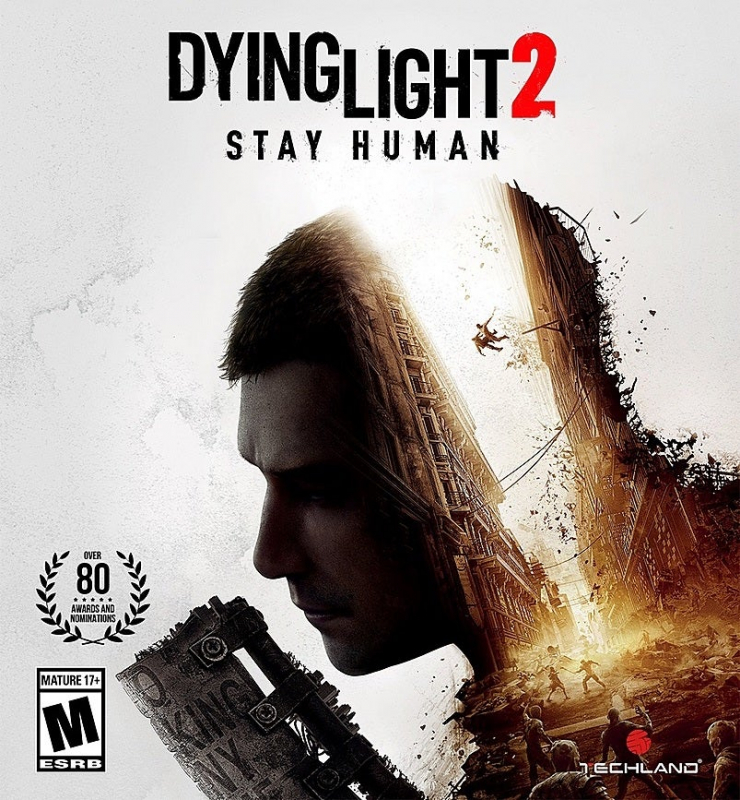

America - Front
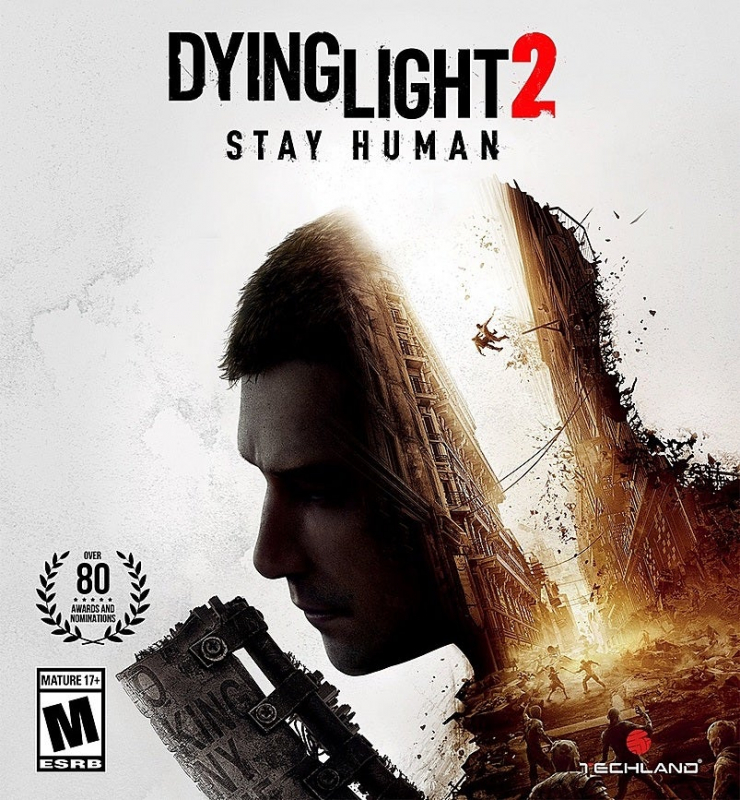

America - Back

Full disclosure: besides receiving a review code, Stride PR also treated me to various physical goodies: several game posters, stickers, a snow cap, a nice ballpoint pen, and a mid-sized leather-bound notebook. This is the first time I've been treated to items beyond a review code (or codes), but I believe I'm still able to assess Dying Light 2 strictly on its merits.
Have you ever played a game that made you ponder what was happening behind closed doors? I typically associate that curiosity with tragically bad games, but it's not exclusive to them though. Despite the organic uplift Techland had after its precursor's success – from critics and sales - Dying Light 2 Stay Human falls into that rarer territory of feeling like an adequately fun title that's so often at odds with itself. It doesn’t capture its narrative and gameplay ambitions as it previously advertised, but fans will certainly appreciate this ambitious effort.
Set 22 years after the events of the first game, Dying Light 2 stars a new generic protagonist: Aiden Caldwell. Despite the Global Relief Effort (GRE) crafting a vaccine against "The Harran Virus," they were back at it again testing new variants. Lo and behold, a more dangerous variant escapes and wipes out most of the world by 2036. Now, Aiden ventures into the walled city of Villedor to find his sister, Mia. To succeed, he must navigate between clashing factions that are all vying for more power over one of humanity's last bastions. 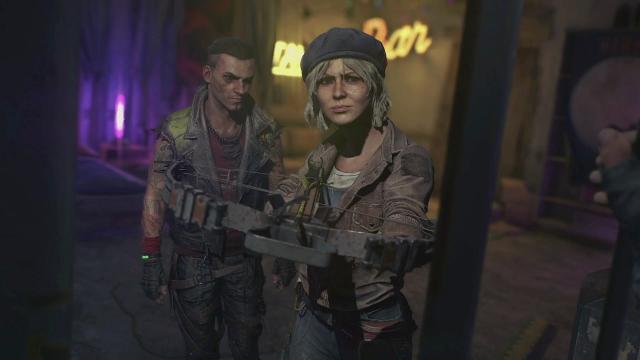
The catch with Aiden is he's a Pilgrim: a vagabond who's been sojourning through a zombie-infested Europe for roughly 15 years. So, the insanely protracted prologue has some heavy-lifting to handle between story and gameplay. New side characters come and go in rapid succession (I eventually forgot a couple of their names), the fundamental basics of the parkour/stealth/melee-action zombie sandbox are laid out, and Aiden's backstory with Mia is shown through monochromatic flashbacks. The last point in particular is a narrative sore spot. The dour atmosphere of child experimentation contrasted with Mia’s cheerful innocence (“Aiden-Bo-Baiden!”) seems more fitting for schlocky B-horror than Stay Human's dramatic intentions.
It speaks to the strength of Old Villedor as a storytelling vehicle once the prologue's portly size and obnoxious railroading melt away. Within minutes of freedom, the area's atmosphere begins taking form: formal police managing infected on the streets, farm plots scattered upon dozens of rooftops and balconies, small groups of citizens chit-chatting around a fire, a haggard woman "singing" a Gaelic tune in a distance, and so on. Your savior in the prologue, Hakon, effectively acts as your guidance counselor for the main story, either directly or via radio. His corny reminiscences of his various wives hits the funny bone as well as Amy Schumer's stand-up, but there's a nice yin-and-yang dynamic between him and Aiden's overwrought seriousness.
Once the open world's gears are turning and more quest-givers request your attention, you get how much rendering an able-bodied community mattered to Techland. Several main and side quests reinforce some small aspect of living during hard times. Accidentally killing a goat turns out beneficial in an unexpected way; likewise, being a pitiful pushover could be exploited by your own family and met with tragic results. These interesting touches (and more I haven't discovered) won't be as noticed unless you indulge some of the better side content though. It helps to slightly enhance the main story – which it desperately needs to do.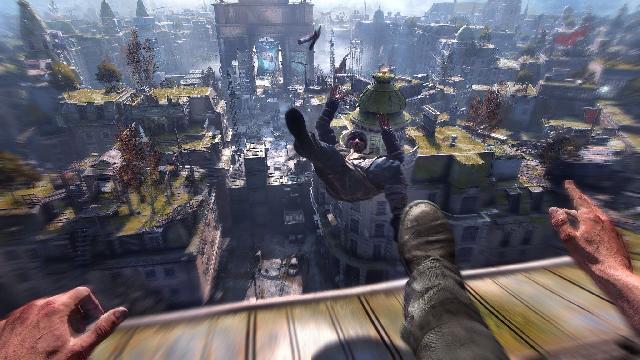
As tangible as the world-building feels on the periphery, there's one big problem: I don’t care what most people have to say. Coming from someone who can happily indulge in GreedFall's fantasy intricacies or Control's paranatural insanity, I couldn't help but skip through most of the generic characters' lines in the early main campaign. There are inspired choices like the father-son duo Alberto & Vincenzo, but the entire conflict between the quasi-fascistic Peacekeepers and Survivor commune mostly serves to burn time. To its credit, it's not serving a simplistic good/evil dynamic. The Peacekeepers' focus is on the legitimate claims of their leader's murder and their appeal to order, which is given slightly more context than "help us make a totalitarian police state." But most of this plot is a contrived trust/mistrust merry-go-round for tension's sake, until dropping it for a different conflict in the second half.
This isn't helped by the story's inconsistent presentation either. The Troy Baker-isms of so many AAA protagonists is used to decent effect with Jonah Scott, and Rosario Dawson's Lawan is a nice surprise, but most prominent side characters sound so dull by comparison. It's hard to say whether that came from the performers or the director's/directors' involvement. Considering how most of the script doesn't have much flavor either, it's hard to judge where more blame should go. Although not among his best work, Olivier Derivière’s soundtrack can – at least – recurrently capture your attention.
Considering how many systems are already being juggled, it's no surprise that Techland's supposedly labyrinthine story choices don't measure up to other RPGs. Most binary decisions, with a countdown timer and screen-morphing visual trick in tow, can be easily telegraphed and most consequences feel limited outside of the epilogue. Even if not massively shifting any results, some are still enjoyable in sculpting "your Aiden." Dilemmas around faction control of water towers or electrical stations feel more inclined towards what gameplay extras you want versus who morally deserves it. Of course I'll give everything to Survivors if it rewards me with more parkour opportunities.
By the end, I occasionally connected with Human's expansive narrative, but rarely during the prologue and epilogue. The community dynamics in Villedor felt more intriguing than what drove Aiden to initially come here. Because of that, the tonally-confused & padded finale ranks as one of its worst portions and an all-around unsatisfying conclusion. When it’s all said and done, the mixed quality of the character roster and frequently-absent emotional investment ranks this as typical zombie fiction.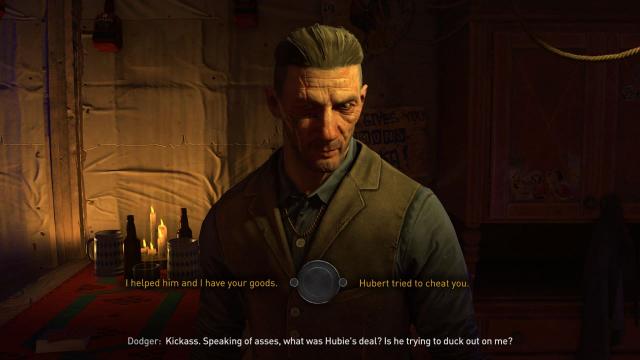
Stay Human's script and hub world inhabitants may be predetermined, but how you scale Villedor is the polar opposite. Along with the expected zombie hordes, the heart of this series is the freeform parkour. A plethora of ramps, yellow-colored ledges, skylights, railings, vehicles, exposed rebar on damaged walls, and more are beckoning you to uncover new ways to reach the next objective. But you're not free to consistently do whatever; in fact, your stamina meter will prove the opposite early on. Once that hits zero, your fall might damage or even kill you. Although there's a bit of subtle magnetism and forgiveness in its parkour system, you still have to be intentional with what you scale. It grows into a reflex over time.
The same can be said for the first-person combat too. There’s a demand to watch telegraphed moves, time your block or dodge, and combine your parkour skills whilst avoiding fatigue. When you have the basics of hacking away down, then supplemental weapons, be they throwing knives or scattered in-game objects, will add more dynamism to these fights. Parkour combat isn't as seamless as it could be, especially during those aggravating times of getting continuously stun-locked, but when you're in the flow state and using everything at your disposal it takes on a special energy.
Ever since Dead Island, Techland has had a fascination with atypical items as legitimate melee weapons. What was once a broken pistol is now strapped to a pole and becomes a gun-hammer; on top of that, perhaps you ratchet on some mods that enable elemental damage or temporary stuns. If you have the blueprints and find enough parts smattered across the world then there's a decent variety to consider.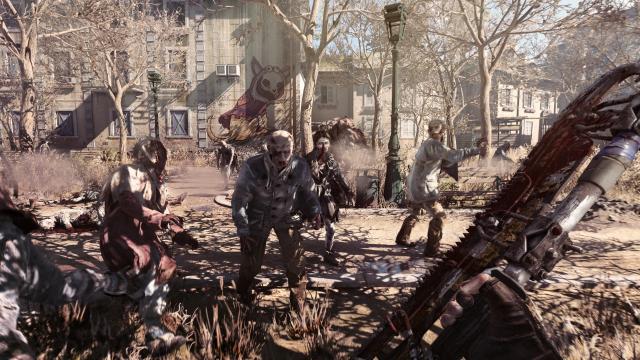
Another wrinkle to the various parkour and combat tactics is about when to act, not just how. Villedor's day/night isn't mere scenery; the undead population ebbs and flows on the streets dependent on the time. Dark Zones hiding great loot (permanent stat boosts, better weapons, etc.) are less crowded and GRE anomalies (bosses) come out of their dens at night. Those crowded streets also have dangerous Howlers, or undead siren alarms, which can instigate the equivalent of a GTA police chase - with each successive 'level' being more dangerous than the last. And since Aiden is infected, there's a ticking clock element for how long he can remain in darkness before turning. Only direct sunlight, UV light, or an immunity booster can repel that effect.
Like Villedor’s world-building, some of Human's best mini-stories are found through gameplay. Take the immunity countdown as one example. One main mission demands you slink through an undead horde in a subway system. Obviously, rudimentary stealth or combat were valid options. An interesting dilemma occurred after I ran out of immunity boosters in a service hallway. When the countdown clock hit 0:00 and Aiden began legitimately turning, all of the zombies patrolling or resting there temporarily vanished from my screen. Perhaps this could've been a bug, but I see it implying how close I got to becoming one of them before just reaching a lone UV lamp on the other side. Enabling my imagination to perceive that trumps the majority of its script.
Overall, these elements mesh together surprisingly well. Plus, the Villedor skylines of the second half and newer traversal items open up your possibilities even further. The audio/visual mastery adds another layer to the atmosphere too. Even though it rarely pushed any 'horror buttons' for me, Techland's audio design does a great job of never making you feel safe at night. From the background noise of someone screaming in the distance to bees buzzing in their rooftop hives, sound mixing is professionally done throughout. Although I have some qualms with the art direction for most zombies and whatnot, graphical fidelity and world design are still commendable. Were I strictly looking at this basic foundation of mechanics, audio, and visuals, it'd have a solid reputation.
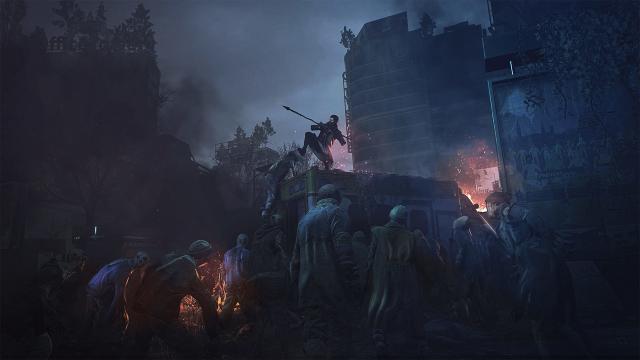
Where Stay Human starts stumbling is the minutiae. Such annoyances actually start at the very beginning: the main menu. It's currently 2022 and I'm still lost as to how other developers think Destiny's controller-cursor and button-holding for certain actions is a good idea. It may seem minor, but why settle for sub-optimal design when menus play an integral role? The checkpoint system follows that dumb structure of respawning away from a battle with all felled enemies and spent items permanently gone. The standard route of redoing battles is better-suited to help players learn from their mistakes than this 'checkpoint-cheesing.' These aspects irked me over time.
Layered on top of these quibbles is a general lethargy for its big-budget tropes. “Survivor Vision” (a la Batman Arkham’s Detective Mode) is a prime example of this. I understand its use in scoping out enemies, in first person no less, but drilling into players’ psyche that incessant need to sonar everywhere detracts from naturally exploring the world. All the delicate building and outdoor work becomes obscured when you’re slavishly sniffing out every interactable drawer or locker. Although there are differences between third- and first-person, compare this distracting element to The Last of Us Part II’s organic exploration during the open-world Seattle section.
Despite mixing together mechanically, I also like how Techland bifurcates combat and parkour experience levels. With that, you’re able to invest your time however you see fit, improving both equally or hyper-fixating on one. Where Stay Human fails is in the skill trees. It immediately feels artificial when the prologue brings it up – especially on the parkour side. A Pilgrim who's survived for years in the wild should have a better starting jump than he does, or at least be able to slide. You don't get what seem like natural starting abilities until many hours in.
The elephant in the room that I've been avoiding is the technical issues – especially at launch. Fortunately, my patience (in single player) paid off in not outright despising my time every 30 minutes; that said, it could still be in much better shape. Occasions like the final boss forcing a restart after clipping through the geometry, me getting stuck in tight spaces and subsequently dying, finnicky platforming moments that'd result in death, and a GRE anomaly disappearing just I was about to win are just a few of the bugs to behold. I'm not even sure I can get 100% on inhibitor upgrades now because one I physically grabbed didn't count and fell through the floor - the icon never disappeared and no hard reset has fixed this issue (yet). Nothing was severe enough to make me reflexively play something else, but it was testing my patience.
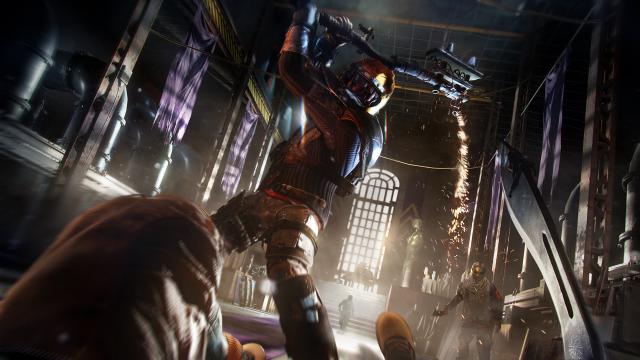
When assessing the sum of its parts, Stay Human's foundation is haphazardly grappling with fun first-person parkour/combat mechanics and every generic AAA open world trope, which is exaggerated to the nth degree thanks to so many uninspired chores for insane completionist numbers. Some of said activities, such as clearing out train stations to unlock fast travel spots, work for the better, while most are filler I couldn't be bothered with. So many design complaints, big or small, pile up and distract from the otherwise engaging core.
Releasing near Stay Human's launch, online co-op (four players max) remains in a rougher state than single player. My overall time was cut short due to annoying pop-in, de-sync, and missing sound effects after joining anyone's party. These inconsistencies started give me a headache. I'd also learned some players were getting corrupted save files after joining lobbies. These cases seemed incredibly rare, but I felt it better to be safe than sorry. I think my limited co-op experience is worth mentioning, but I'd still be content enough solely evaluating this as a single player title.
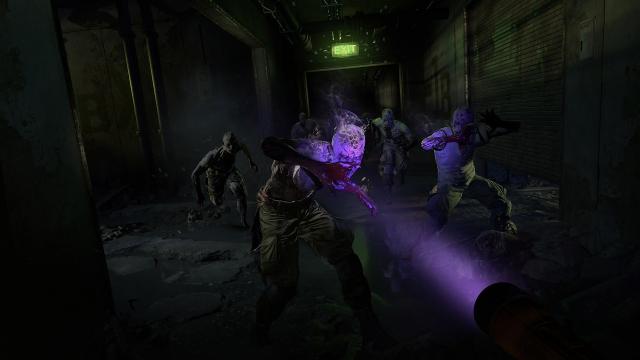
Credit where it's due, Techland swings for the fences when making a sequel. But there's an inherent danger in that too. By trying to wrestle with a mixture of parkour/stealth/combat mechanics, a large open world, and reactive storytelling within a rotund narrative, it starts to buckle from its lesser elements and annoying technical problems. Some of my criticisms will be like water off a duck’s back to the series’ ardent fans, but that’s as far as I can recommend it in its current state.
Contractor by trade and writer by hobby, Lee's obnoxious criticisms have found a way to be featured across several gaming sites: VGChartz, Gaming Nexus, DarkStation, and TechRaptor! He started gaming in the mid-90s and has had the privilege in playing many games across a plethora of platforms. Reader warning: each click given to his articles only helps to inflate his Texas-sized ego. Proceed with caution.









